國會太空榮譽勳章
| 國會太空榮譽勳章 | |
|---|---|
 國會太空榮譽勳章正面 | |
| 類型 | 獎章 |
| 授予原因 | 「為民族和人類的繁榮做出特別令人稱道的努力和貢獻的人」 |
| 國家/地區 | 美國 |
| 頒發單位 | 美國國會 |
| 頒授資格 | NASA宇航員 |
| 狀態 | 現役 |
| 設立時間 | 1969年9月29日 |
| 首次頒發 | 1978年10月1日 |
| 最近頒發 | 2006年4月26日 |
| 頒發總數 | 28枚 |
| 追授總數 | 17枚 |
國會太空榮譽勳章絲帶 | |
| 優先順序 | |
| 下等 | NASA傑出服務獎章 |
國會太空榮譽勳章(英語:Congressional Space Medal of Honor)是美國國家航空暨太空總署(NASA)頒發的一種獎章,授予「為民族和人類的繁榮做出特別令人稱道的努力和貢獻的宇航員」[1]。是NASA授予的最高榮譽,獎章由美國總統以美國國家航空暨太空總署署長和副署長的名義頒發。國會太空榮譽勳章和榮譽勳章不同,後者為一種軍事榮譽,授予「在與敵對武裝力量的戰鬥中冒生命危險並且超越了職責範疇,展現出的(極為顯著的)超凡的英勇行為的人」。兩者均為所屬領域的最高級別榮譽勳章[2]。國會太空榮譽勳章一般配以具有象徵著美國海軍陸戰隊、美國海軍、美國空軍、美國海岸警衛隊等美國所有軍種的不同顏色裝飾的色帶做裝飾。
獲得國會太空榮譽勳章的宇航員通常要在NASA指派的太空飛行任務中作出極為不尋常的貢獻。通常情況下,是獎勵在航天科技領域有特別傑出的貢獻,或者執行了一項里程碑式的任務的宇航員。在個別情況下,對於在任務中成功挽救嚴重突發情況的宇航員,同樣可以授予該獎。截至2004年,時任美國總統的小布希為在挑戰者號災難和哥倫比亞號災難中獻出生命的14名宇航員追授該勳章後,所有在任務中犧牲的宇航員均獲得了該項殊榮。[3]
至今,一共有五位總統授予過該項榮譽,他們分別是吉米·卡特、隆納·雷根、喬治·赫伯特·沃克·布希、比爾·柯林頓和喬治·沃克·布希。其中喬治·沃克·布希授予最多,他分別向14名在任務中犧牲的宇航員以及另外兩名有傑出貢獻的宇航員授予了這項榮譽。
獲得者列表
[編輯]截止2013年8月,共有26名宇航員獲得這項殊榮。其中有17位為身後追授,其中包括在1986年1月28日挑戰者號太空梭災難和2003年2月1日哥倫比亞號災難中獻出生命的14名宇航員,以及在1967年1月27日阿波羅1號火災事故中不幸喪生的3名宇航員。「*」號代表追授。[2][4]
| 照片 | 宇航員名字 | 授予日期 | 授予勳章的總統 | 備註 | 來源 |
|---|---|---|---|---|---|

|
尼爾·阿姆斯壯 | 1978年10月1日 | 吉米·卡特 | 阿波羅11號(首次登月任務指揮官,[5]第一個登上月球的人[6]) | [2] |

|
弗蘭克·博爾曼 | 1978年10月1日 | 吉米·卡特 | 阿波羅8號(首次環繞月任務的指揮官[7]) | [2] |
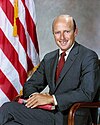
|
皮特·康拉德 | 1978年10月1日 | 吉米·卡特 | 天空實驗室2號(天空實驗室首位指揮官,[8][9]為排除空間站故障作出突出貢獻[10]) | [2] |
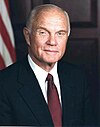
|
約翰·赫雪爾·葛倫 | 1978年10月1日 | 吉米·卡特 | 水星-宇宙神6號(首位進入地球軌道的美國宇航員)[11] | [2] |

|
維吉爾·葛利森* | 1978年10月1日 | 吉米·卡特 | 阿波羅1號, 雙子星3號和水星-紅石4號(雙子星3號首位指揮官)[12];在阿波羅1號火災事故中喪生[13] | [2] |
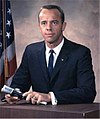
|
艾倫·雪帕德 | 1978年10月1日 | 吉米·卡特 | 水星-紅石3號(首位進入太空的美國宇航員)[14] | [2] |

|
約翰·楊 | 1981年5月19日 | 隆納·雷根 | STS-1(首位航天飛機任務指揮官)[15] | [2] |
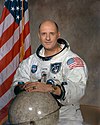
|
托馬斯·斯塔福德 | 1993年1月19日 | 喬治·赫伯特·沃克·布希 | 阿波羅-聯盟測試計劃(美國指揮官)[16] | [2] |

|
吉姆·洛弗爾 | 1993年7月26日 | 比爾·柯林頓 | 阿波羅13號(挽回發生嚴重事故的飛船的指揮官)[17][18] | [2] |

|
珊農·露茜德 | 1996年12月2日 | 比爾·柯林頓 | 在太空執行任務最久的女性宇航員[19] | [2] |
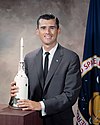
|
羅傑·查菲* | 1997年12月17日 | 比爾·柯林頓 | 在阿波羅1號火災事故中喪生[20] | [2] |
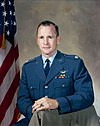
|
愛德華·懷特* | 1997年12月17日 | 比爾·柯林頓 | 阿波羅1號和雙子星4號(首次進行艙外活動的美國宇航員);在阿波羅1號火災事故中喪生[21][22] | [2] |
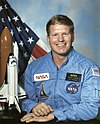
|
威廉·謝潑德 | 2003年1月15日 | 喬治·沃克·布希 | 遠征1(首位國際太空站指揮官)[23] | [2] |
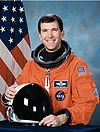
|
里克·赫斯本德* | 2004年2月3日 | 喬治·沃克·布希 | STS-107(在哥倫比亞號災難中喪生)[24] | [2] |
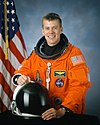
|
威廉·麥庫爾* | 2004年2月3日 | 喬治·沃克·布希 | STS-107(在哥倫比亞號災難中喪生)[24] | [2] |

|
邁克爾·安德森* | 2004年2月3日 | 喬治·沃克·布希 | STS-107(在哥倫比亞號災難中喪生)[24] | [2] |

|
卡爾帕娜·喬拉* | 2004年2月3日 | 喬治·沃克·布希 | STS-107(在哥倫比亞號災難中喪生)[24] | [2] |

|
大衛·布朗* | 2004年2月3日 | 喬治·沃克·布希 | STS-107(在哥倫比亞號災難中喪生)[24] | [2] |

|
勞雷爾·克拉克* | 2004年2月3日 | 喬治·沃克·布希 | STS-107(在哥倫比亞號災難中喪生)[24] | [2] |
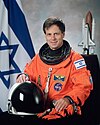
|
伊蘭·拉蒙* | 2004年2月3日 | 喬治·沃克·布希 | STS-107(在哥倫比亞號災難中喪生,唯一一位非美國籍的獲獎者)[24][25] | [2] |

|
迪克·斯科比* | 2004年7月23日 | 喬治·沃克·布希 | STS-51-L(在挑戰者號災難中喪生)[26] | [2] |

|
邁克爾·約翰·史密斯* | 2004年7月23日 | 喬治·沃克·布希 | STS-51-L(在挑戰者號災難中喪生)[26] | [2] |

|
朱迪斯·蕾斯尼克* | 2004年7月23日 | 喬治·沃克·布希 | STS-51-L(在挑戰者號災難中喪生)[26] | [2] |

|
羅納德·麥克內爾* | 2004年7月23日 | 喬治·沃克·布希 | STS-51-L(在挑戰者號災難中喪生)[26] | [2] |
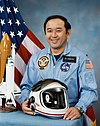
|
鬼塚承次* | 2004年7月23日 | 喬治·沃克·布希 | STS-51-L(在挑戰者號災難中喪生)[26] | [2] |

|
格里高利·賈維斯* | 2004年7月23日 | 喬治·沃克·布希 | STS-51-L(在挑戰者號災難中喪生)[26] | [2] |

|
克里斯塔·麥考利芙* | 2004年7月23日 | 喬治·沃克·布希 | STS-51-L(在挑戰者號災難中喪生,太空計劃教師)[26] | [2] |
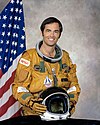
|
羅伯特·克里彭 | 2006年4月26日 | 喬治·沃克·布希 | STS-1(首次航天飛機任務飛行員)[27] | [2] |
參考文獻
[編輯]- ^ 14 CFR 1221.201 - Basis for award of the medal. Cornell University Law School. [2013-09-10]. (原始內容存檔於2020-04-12).
astronaut who in the performance of his duties has distinguished himself by exceptionally meritorious efforts and contributions to the welfare of the Nation and of mankind.
- ^ 2.00 2.01 2.02 2.03 2.04 2.05 2.06 2.07 2.08 2.09 2.10 2.11 2.12 2.13 2.14 2.15 2.16 2.17 2.18 2.19 2.20 2.21 2.22 2.23 2.24 2.25 2.26 2.27 2.28 2.29 List of Awardees by NASA. NASA. [2013-09-09]. (原始內容存檔於2013-07-02).
Despite the medal's name, the President awards this medal based upon recommendations from the NASA Administrator. Congress authorized the President to "award, and present in the name of Congress, a medal of appropriate design, which shall be known as the Congressional Space Medal of Honor, to any astronaut who in the performance of his duties has distinguished himself by exceptionalIy meritorious efforts and contributions to the welfare of the Nation and of mankind."
- ^ CHALLENGER CREW HONORED WITH CONGRESSIONAL SPACE MEDAL OF HONOR Congressional Space Medal of Honor Winners. collectSPACE.com. [2013-09-09]. (原始內容存檔於2011-03-07).
- ^ Congressional Space Medal of Honor Winners. Pinterest. [2013-09-09]. (原始內容存檔於2020-04-12).
- ^ Orloff, Richard W. Table of Contents. Apollo by the Numbers: A Statistical Reference. NASA History Division, Office of Policy and Plans. NASA History Series (Washington, D.C.: NASA). 2004年9月 [First published 2000] [2013-06-12]. ISBN 0-16-050631-X. LCCN 00-061677. NASA SP-2000-4029. (原始內容存檔於2007-08-23).
- ^ Apollo 11 Mission Summary. The Apollo Program. Smithsonian National Air and Space Museum. [2013-09-10]. (原始內容存檔於2013-08-29).
- ^ Frank Borman. NNDB. [2013-09-10]. (原始內容存檔於2013-09-02).
Commander of the 1968 Apollo 8 Mission, Frank Borman led the first team of astronauts to leave Earth's gravity and orbit the Moon.
- ^ Third Man to Walk on Moon Dies in Accident. NASA. [2013-09-10]. (原始內容存檔於2006-06-13).
Commander, Apollo XII.
- ^ NASA Honors Apollo 12 Commander Charles Conrad. NASA. [2013-09-09]. (原始內容存檔於2013-01-30).
- ^ Jeff Bezos' Salvaged Apollo Rocket Engines Reach Shore After Ocean Recovery. Space.com. [2013-09-10]. (原始內容存檔於2013-04-08).
- ^ Biography of John H. Glenn. NASA. [2013-09-09]. (原始內容存檔於2007-10-14).
On February 20, 1962, Glenn piloted the Mercury-Atlas 6 "Friendship 7" spacecraft on the first manned orbital mission of the United States.
- ^ Remembering Gus Grissom, NASA's most controversial astronaut. Dvice. [2013-09-09]. (原始內容存檔於2015-01-03).
Gus Grissom was the second American to go up into space, and the first to do it twice. He was an active influence on all of NASA's initial manned spaceflight programs, starting with his controversial Mercury flight, then on to Gemini and, finally, Apollo, where Gus Grissom would make the ultimate sacrifice.
- ^ Apollo 1: Gus Grissom, Ed White, Roger Chaffee. Time. [2013-09-09]. (原始內容存檔於2020-08-15).
The astronauts were killed almost instantly, not only because of the fire but because of another, unforgivably shoddy piece of engineering: the hatch.
- ^ Who Was Alan Shepard?. NASA. [2013-09-09]. (原始內容存檔於2012-09-24).
Alan Shepard was the first American in space. He was one of NASA's first seven astronauts. He also walked on the moon.
- ^ Who Was Alan Shepard?. NASA. [2013-09-10]. (原始內容存檔於2013-02-16).
- ^ THOMAS P. STAFFORD, LIEUTENANT GENERAL, USAF (RET.). NASA. [2013-09-10]. (原始內容存檔於2013-02-18).
- ^ James A. Lovell (Captain, USN, Ret.). NASA. [2013-09-10]. (原始內容存檔於2013-08-10).
- ^ "Houston, We've Had a Problem". NASA.gov. [2013-09-10]. (原始內容存檔於2012-10-17).
- ^ Enduring Qualities. NASA.gov. [2013-09-10]. (原始內容存檔於2012-10-18).
Lucid sailed through Norm Thagard’s 115-day record for the longest American time in orbit.
- ^ NASA Honors Roger Chaffee With Exploration Award. NASA. [2013-09-09]. (原始內容存檔於2012-10-21).
Chaffee and his crewmates Gus Grissom and Ed White lost their lives on Jan. 27, 1967, in a fire aboard the Apollo Command Module during a preflight test on the launch pad.
- ^ Ed White: First American Spacewalker. NASA. [2013-09-09]. (原始內容存檔於2012-01-26).
On June 3, 1965, Edward H. White II became the first American to step outside his spacecraft and let go, effectively setting himself adrift in the zero gravity of space.
- ^ Detailed Biographies of Apollo I Crew - Ed White. NASA. [2013-09-10]. (原始內容存檔於2013-02-25).
- ^ 2010 Interview: Bill Shepherd. NASA. [2013-09-10]. (原始內容存檔於2012-11-02).
The Expedition 1 crew members - Commander Bill Shepherd.
- ^ 24.0 24.1 24.2 24.3 24.4 24.5 24.6 Report of Columbia Accident Investigation Board (PDF). NASA. [2013-09-09]. (原始內容存檔 (PDF)於2020-12-21).
- ^ Ilan Ramon was a hero before he even left the ground. NASA. [2013-09-10]. (原始內容存檔於2013-09-10).
- ^ 26.0 26.1 26.2 26.3 26.4 26.5 26.6 STS-51L. NASA. [2013-09-10]. (原始內容存檔於2013-03-28).
STS-51L Crew photo with Commander Francis R. Scobee, Pilot Michael J. Smith, Mission Specialists Judith A. Resnik, Ellison S. Onizuka, Ronald E. McNair and Payload Specialists Gregory B. Jarvis and Sharon Christa McAuliffe. I
- ^ ROBERT L. CRIPPEN. NASA. [2013-09-10]. (原始內容存檔於2012-10-25).
e was the pilot of the first orbital test flight of the Shuttle program (STS-1, April 12-14,1981)
